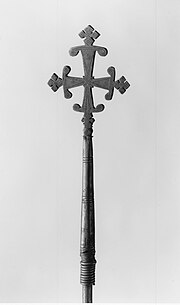BWV 56
|
Ich will den Kreuzstab gerne tragen BWV 56 |
|
|---|---|
| Church cantata by J. S. Bach | |

Cross and Staff, Brooklyn Museum
|
|
| Occasion | 19th Sunday after Trinity |
| Performed | 27 October 1726: Leipzig |
| Movements | 5 |
| Cantata text | Christoph Birkmann |
| Chorale | by Johann Franck |
| Vocal | |
| Instrumental |
|
Ich will den Kreuzstab gerne tragen ("I will the cross-staff gladly carry" or "I will gladly carry the Cross"), BWV 56, is a church cantata by Johann Sebastian Bach. He composed the solo cantata for bass in Leipzig for the 19th Sunday after Trinity Sunday and first performed it on 27 October 1726. The cantata is regarded as part of Bach's third annual cycle of cantatas for all occasions of the liturgical year, and one of few works for which Bach himself used the term cantata.
The text by Christoph Birkmann reflects life of the Christian as a voluntary journey "carrying the cross" as a follower of Jesus. The text refers indirectly to the prescribed gospel reading which tells that Jesus traveled by boat, which on the other hand refers to a navigational instrument called Kreuzstab, the Jacob's staff. The poet used the imagery to liken life to a sea voyage, finally reflecting a yearning for death to reach the ultimate destination. The yearning for death is re-enforced by the choice of a closing chorale, the stanza "Komm, o Tod, du Schlafes Bruder" (Come, o death, you brother of sleep) from Johann Franck's 1653 hymn "Du, o schönes Weltgebäude" which also relates to the ship voyage imagery. Bach, who composed the cantata in his fourth year as Thomaskantor in Leipzig, structured the cantata in five movements, alternating arias and recitatives for a bass soloist and closing with a four-part chorale, and chose an ensemble of Baroque instruments of three woodwind instruments (two oboes and taille) playing mostly with three string instruments (two violins and viola), and continuo, with an obbligato cello in the first recitative and an obbligato oboe in the second aria, resulting in different timbres for the four movements for the same voice part.
...
Wikipedia
